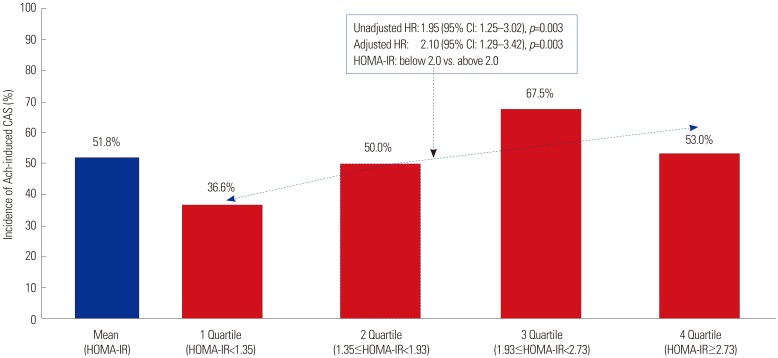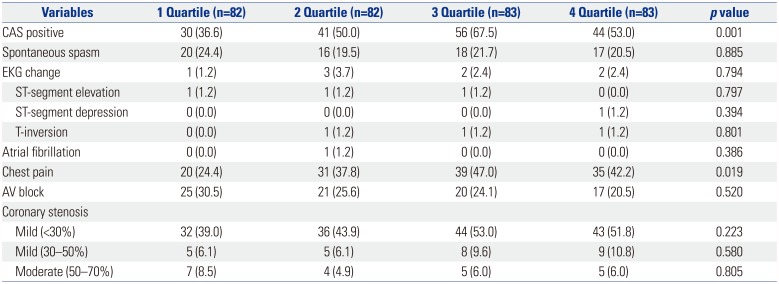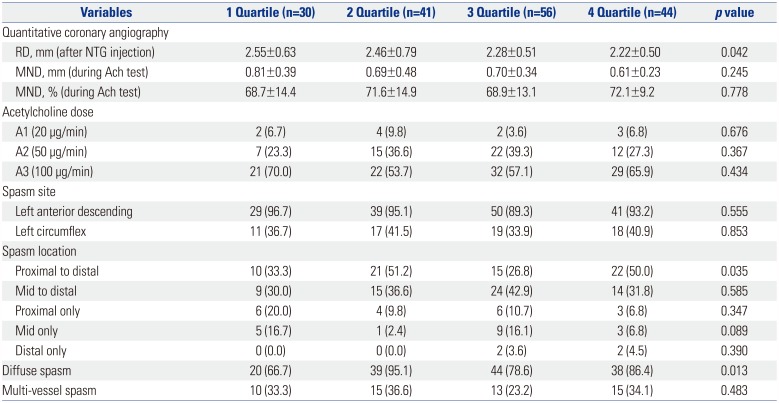1. Kugiyama K, Ohgushi M, Motoyama T, Sugiyama S, Ogawa H, Yoshimura M, et al. Nitric oxide-mediated flow-dependent dilation is impaired in coronary arteries in patients with coronary spastic angina. J Am Coll Cardiol. 1997; 30:920–926. PMID:
9316519.

2. Yasue H, Nakagawa H, Itoh T, Harada E, Mizuno Y. Coronary artery spasm--clinical features, diagnosis, pathogenesis, and treatment. J Cardiol. 2008; 51:2–17. PMID:
18522770.

3. Stern S, Bayes de Luna A. Coronary artery spasm: a 2009 update. Circulation. 2009; 119:2531–2534. PMID:
19433770.
4. Lanza GA, Careri G, Crea F. Mechanisms of coronary artery spasm. Circulation. 2011; 124:1774–1782. PMID:
22007100.

5. Ong P, Athanasiadis A, Hill S, Vogelsberg H, Voehringer M, Sechtem U. Coronary artery spasm as a frequent cause of acute coronary syndrome: The CASPAR (Coronary Artery Spasm in Patients With Acute Coronary Syndrome) Study. J Am Coll Cardiol. 2008; 52:523–527. PMID:
18687244.
6. Laporte F, Moulin F, Brembilla-Perrot B. Sudden death caused by atypical variant angina. Arch Cardiovasc Dis. 2011; 104:480–481. PMID:
21944150.

7. Diabetes mellitus: a major risk factor for cardiovascular disease. A joint editorial statement by the American Diabetes Association; The National Heart, Lung, and Blood Institute; The Juvenile Diabetes Foundation International; The National Institute of Diabetes and Digestive and Kidney Diseases; and The American Heart Association. Circulation. 1999; 100:1132–1133. PMID:
10477541.
8. American Diabetes Association. Diagnosis and classification of diabetes mellitus. Diabetes Care. 2013; 36(Suppl 1):S67–S74. PMID:
23264425.
9. Li YJ, Hyun MH, Rha SW, Chen KY, Jin Z, Dang Q, et al. Diabetes mellitus is not a risk factor for coronary artery spasm as assessed by an intracoronary acetylcholine provocation test: angiographic and clinical characteristics of 986 patients. J Invasive Cardiol. 2014; 26:234–239. PMID:
24907077.
10. Choi BG, Park SH, Rha SW, Ahn J, Choi SY, Byun JK, et al. Three-year follow-up of patients with acetylcholine-induced coronary artery spasm combined with insignificant coronary stenosis. Int J Cardiol. 2017; 238:66–71. PMID:
28457560.

11. Choi BG, Jeon SY, Rha SW, Park SH, Shim MS, Choi SY, et al. Impact of renin-angiotensin system inhibitors on long-term clinical outcomes of patients with coronary artery spasm. J Am Heart Assoc. 2016; 5:e003217. PMID:
27444508.

12. Choi BG, Rha SW, Park T, Choi SY, Byun JK, Shim MS, et al. Impact of cigarette smoking: a 3-year clinical outcome of vasospastic angina patients. Korean Circ J. 2016; 46:632–638. PMID:
27721853.

13. Choi BG, Park SH, Rha SW, Park JY, Choi SY, Park Y, et al. Five-year clinical outcomes in patients with significant coronary artery spasm: a propensity score-matched analysis. Int J Cardiol. 2015; 184:533–539. PMID:
25767010.

14. Im SI, Rha SW, Choi BG, Choi SY, Kim SW, Na JO, et al. Angiographic and clinical characteristics according to intracoronary acetylcholine dose in patients with myocardial bridge. Cardiology. 2013; 125:250–257. PMID:
23816809.

15. Legro RS, Castracane VD, Kauffman RP. Detecting insulin resistance in polycystic ovary syndrome: purposes and pitfalls. Obstet Gynecol Surv. 2004; 59:141–154. PMID:
14752302.

16. DeFronzo RA, Ferrannini E. Insulin resistance. A multifaceted syndrome responsible for NIDDM, obesity, hypertension, dyslipidemia, and atherosclerotic cardiovascular disease. Diabetes Care. 1991; 14:173–194. PMID:
2044434.

17. Petersen KF, Dufour S, Savage DB, Bilz S, Solomon G, Yonemitsu S, et al. The role of skeletal muscle insulin resistance in the pathogenesis of the metabolic syndrome. Proc Natl Acad Sci U S A. 2007; 104:12587–12594. PMID:
17640906.

18. JCS Joint Working Group. Guidelines for diagnosis and treatment of patients with vasospastic angina (coronary spastic angina) (JCS 2008): digest version. Circ J. 2010; 74:1745–1762. PMID:
20671373.
19. Muniyappa R, Montagnani M, Koh KK, Quon MJ. Cardiovascular actions of insulin. Endocr Rev. 2007; 28:463–491. PMID:
17525361.

20. Baron AD. Hemodynamic actions of insulin. Am J Physiol. 1994; 267(2 Pt 1):E187–E202. PMID:
8074198.

21. Steinberg HO, Chaker H, Leaming R, Johnson A, Brechtel G, Baron AD. Obesity/insulin resistance is associated with endothelial dysfunction. Implications for the syndrome of insulin resistance. J Clin Invest. 1996; 97:2601–2610. PMID:
8647954.

22. Lee CH, Shih AZ, Woo YC, Fong CH, Leung OY, Janus E, et al. Optimal cut-offs of homeostasis model assessment of insulin resistance (HOMA-IR) to identify dysglycemia and type 2 diabetes mellitus: a 15-year prospective study in Chinese. PLoS One. 2016; 11:e0163424. PMID:
27658115.

23. Arcaro G, Cretti A, Balzano S, Lechi A, Muggeo M, Bonora E, et al. Insulin causes endothelial dysfunction in humans: sites and mechanisms. Circulation. 2002; 105:576–582. PMID:
11827922.
24. DeFronzo RA. Insulin resistance, lipotoxicity, type 2 diabetes and atherosclerosis: the missing links. The Claude Bernard Lecture 2009. Diabetologia. 2010; 53:1270–1287. PMID:
20361178.

25. Potenza MA, Addabbo F, Montagnani M. Vascular actions of insulin with implications for endothelial dysfunction. Am J Physiol Endocrinol Metab. 2009; 297:E568–E577. PMID:
19491294.

26. Nakagomi A, Saiki Y, Kosugi M, Kohashi K, Yoshikawa Y, Yamane Y, et al. Effect of insulin resistance associated with compensatory hyperinsulinemia on the long-term prognosis in patients with vasospastic angina. Int J Cardiol. 2013; 167:2222–2227. PMID:
22748286.

27. Knowler WC, Barrett-Connor E, Fowler SE, Hamman RF, Lachin JM, Walker EA, et al. Reduction in the incidence of type 2 diabetes with lifestyle intervention or metformin. N Engl J Med. 2002; 346:393–403. PMID:
11832527.

28. Tuomilehto J, Lindström J, Eriksson JG, Valle TT, Hämäläinen H, Ilanne-Parikka P, et al. Prevention of type 2 diabetes mellitus by changes in lifestyle among subjects with impaired glucose tolerance. N Engl J Med. 2001; 344:1343–1350. PMID:
11333990.

29. Rha SW, Choi BG, Seo HS, Park SH, Park JY, Chen KY, et al. Impact of statin use on development of new-onset diabetes mellitus in Asian population. Am J Cardiol. 2016; 117:382–387. PMID:
26732422.










 PDF
PDF ePub
ePub Citation
Citation Print
Print



 XML Download
XML Download